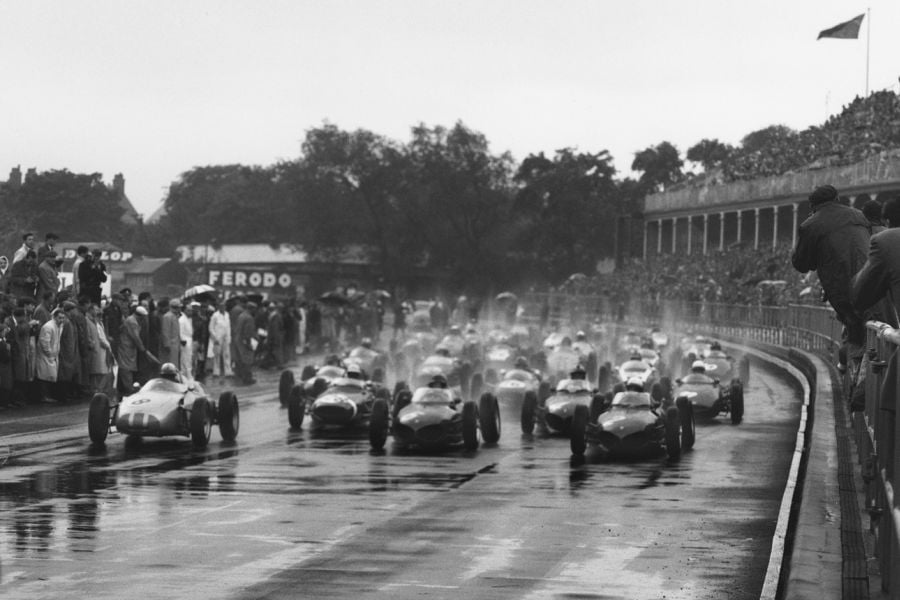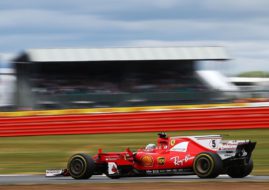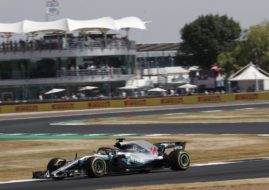Aintree Circuit - The Place Where Motorsport History was Written
Aintree Circuit (full name Aintree Motor Racing Circuit), located in the village of Aintree near Liverpool, England, is one of the historical sites of the world’s motorsport, the venue which hosted the Formula One British Grand Prix five times between 1955 and 1962, plus eleven more non-championship Formula One races.
The 3-mile Grand Prix track was opened in 1954
The 3-mile (4.83 km) Grand Prix race track was opened in 1954 and it was in use until 1964. Since then, only the 1.5-mile Club Circuit was in use. It’s interesting that motor racing circuit is located within the famous Aintree Racecourse and used the same grandstands as horse racing. Both horse racing and motor racing tracks are still in use today.
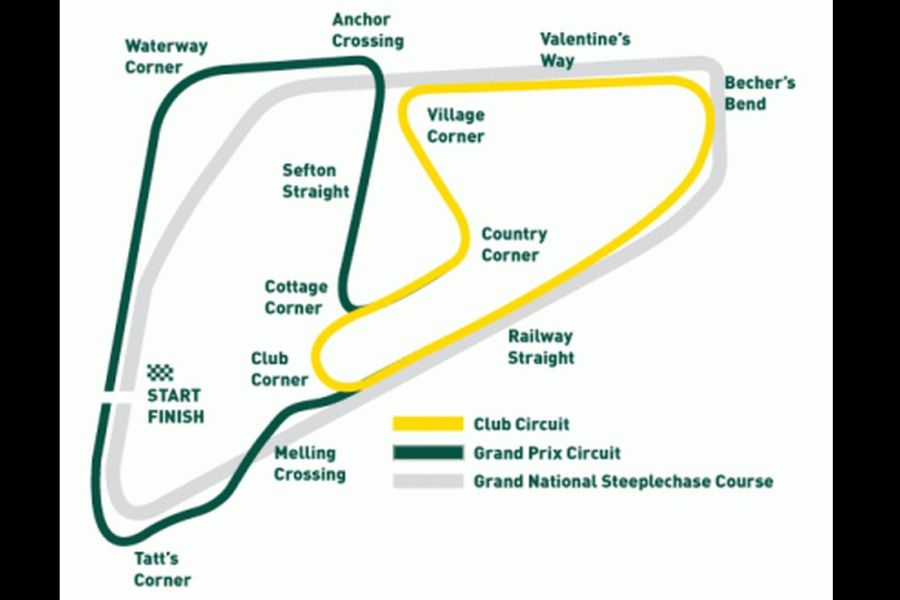
Map: Aintree Racecourse track layout – all three tracks
The Aintree Racecourse is the venue of the Grand National
The Aintree Racecourse was opened in 1829 and it was hosting the Grand National steeplechase race since 1839. It became one of the greatest horse races in the world. The idea of combining horse and car racing appeared in the early 1950s. In that time, the Aintree owner was Mirabel Topham. Shortly after she visited Goodwood, the idea of building the “Goodwood of the North“ was born.
Horse racing track was ready to host Formula 1
In 1950, the inaugural Formula One Championship was held and the British Grand Prix regularly took place at Silverstone in the following years. The CSI (Commission Sportive Internationale), the forerunner of today’s FIA, was persuaded by Aintree officials that the new circuit would make a good home for the British Grand Prix. The big advantage of Aintree was existing facilities which regularly hosted the largest horse race in Britain, so it would not be a problem to host a Formula One race.
The 3-mile circuit was built at a cost of £100,000 in just four months, opening in May 1954. The most of the circuit was following the horse racing with one technical infield section. The smaller club course was also constructed. The circuit was initially driven anti-clockwise, but in 1955 the racing direction was reversed.

Stirling Moss and Juan Manuel Fangio at 1955 British Grand Prix
Stirling Moss was a double winner in the inaugural event
On May 29, 1954, the circuit hosted the inaugural event with several races. In front of 25,000 spectators, Stirling Moss won the main race, named Aintree International 200, driving a Maserati 250F. Moss was also the winner of the 500cc race, driving his Beart-tuned Cooper-Norton. Duncan Hamilton took sports-car honors in his Jaguar C Type, beating Carroll Shelby in an Aston Martin DB3S.
Formula One came to Aintree in 1955
The idea of the British Grand Prix at Aintree became true in July 1955, when the British round of the Formula One Championship was moved from Silverstone to Merseyside. Stirling Moss led a Mercedes 1-2-3-4 domination, scoring not only his maiden F1 victory but also becoming the first British driver to win the British Grand Prix. He crossed the finish line for the blink of an eye ahead of teammate Juan Manuel Fangio. To this day it remained a mystery is this victory a ‘gift’ from Mercedes to satisfy British crowd.
In 1956, the Grand Prix race returned to Silverstone, Aintree again hosted the non-championship race. Stirling Moss was the winner for the third time in a row, driving Maserati 250F again.
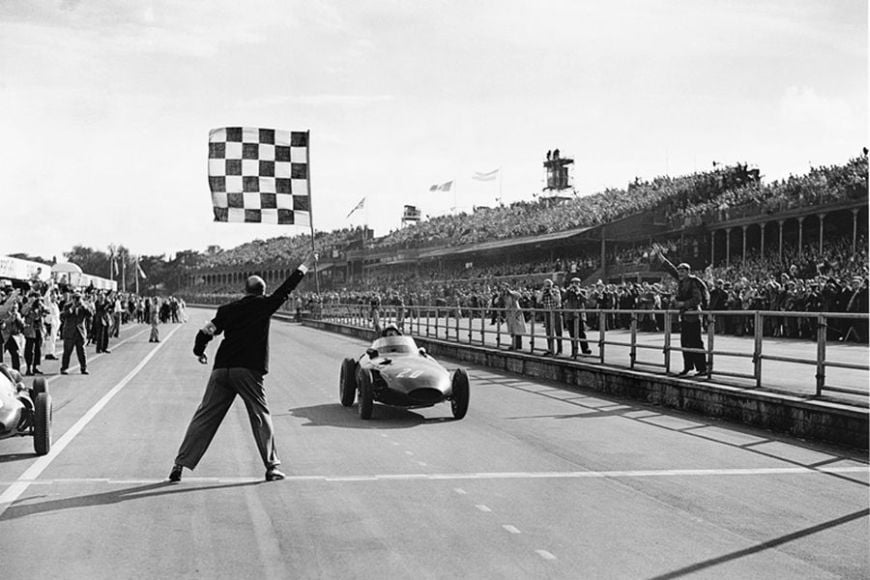
Stirling Moss at 1957 British Grand Prix
British drivers in a British car won the 1957 British Grand Prix
Another historic race followed in 1957, then the British Grand Prix visited Aintree for the second time. It was a race in which Stirling Moss and Tony Brooks were sharing the #20 Vanwall 57, winning the race ahead of three Ferraris. It was the first time British drivers won the British Grand Prix in a British car.
In 1958, it was a time for Silverstone to host British Grand Prix. Aintree circuit hosted Aintree 200. Stirling Moss was the winner again. This time, he was driving Cooper T45-Climax for Rob Walker Racing.

Jack Brabham won the 1959 British Grand Prix
Brabham, von Trips, Clark – Grand Prix winners at Aintree
The third edition of the British Grand Prix at Aintree took place in July 1959. Jack Brabham won the race, driving a Cooper-Climax. Stirling Moss (BRM) and Bruce McLaren (Cooper) completed a podium. In 1960, Stirling Moss won the Aintree 200 race, driven under Formula 2 rules, in a Porsche.
The Formula One Championship came to Aintree two more times. In July 1961, Ferrari’s Wolfgang von Trips won the race ahead of teammates Phil Hill and Richie Ginther. It was von Trips’ last win as he was killed two months later at the Italian Grand Prix. The race was also marked by unusual four-wheel-drive Ferguson P99, entered by Rob Walker Racing Team. The car was driven by Jack Fairman and British hero Stirling Moss but it was disqualified because of receiving assistance on the track.
Jim Clark won the 1962 British Grand Prix, leading from lights to flag in the #20 Lotus 25-Climax. John Surtees finished in the second place, Bruce McLaren completed a podium.

Wolfgang von Trips and Stirling Moss at 1961 British Grand Prix
Since 1964, only the Club Circuit was in use
In 1964, the British Grand Prix moved south to Brands Hatch and never returned to the North. Even the unrivaled spectator facilities could not save the loss of Grand Prix because the safety features of Aintree’s race track wasn’t suitable for rising speeds of Formula One cars. Since 1964, only the short Club Circuit was in use.
In that time, the Aintree Circuit Club (ACC) was responsible for the maintenance and management of the track. In 1964, the Club President Mrs Topham announced that Aintree was to be sold off for redevelopment. It took years until the circuit was finally sold to the Walton Group owned by property developer William Davies in 1973.
The Racing Driver’s School was opened in 1977
In 1976, the management of the course was passed onto bookmakers Ladbrokes, on a year-by-year basis until 1983. The ACC enjoyed an excellent working relationship with the new management and was given complete autonomy over the running of the racing circuit. In 1977, a club member Richard Peacock opened the Aintree Racing Driver’s School.
In the summer of 1982, the facility was once again put up for sale and that led to discontinuation of car racing. Only the Racing Driver’s School continued to operate. Bike racing was still permitted, as it was considered that bikes cause less damage on the horse track.
Sprint races and track days in the 1980s
In 1984, the ACC rebounded, organizing its first Single Venue Tarmac rally at the track – something it would continue to do until 1990. In 1985, they also reintroduced sprinting to the venue and by 1991, the club was running two rounds of the British Sprint Championship – the only club to do so, with a total of five sprints per year. Saturday track days were also introduced in 1987.
The economic depression in the mid-1990s reduced all events and also resulted in the closure of the racing school. In 1997, the ACC announced plans for a major event that would run on the full 3.0-mile circuit to celebrate the 40th Anniversary of the historic 1957 Grand Prix. Unfortunately, the event had to be canceled due to difficulties with the racecourse management.
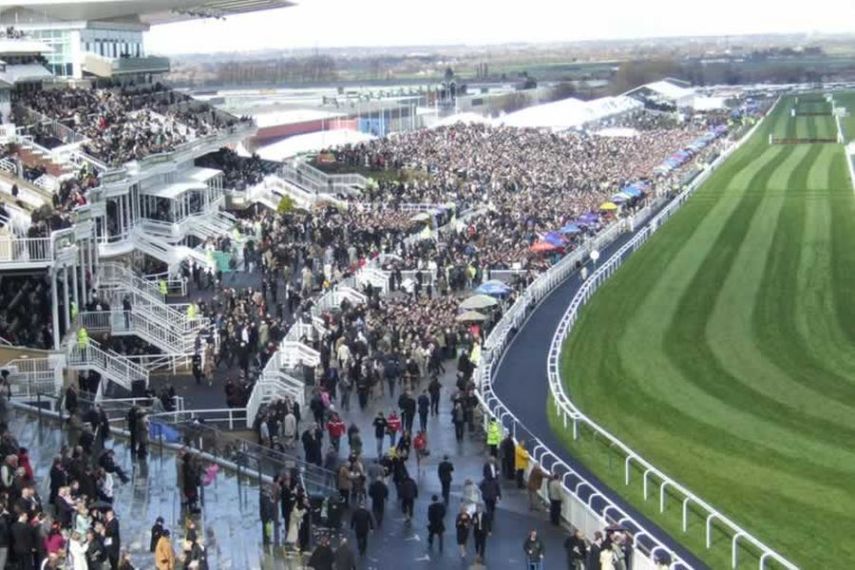
A crowd at the Grand National steeplechase at Aintree Racecourse
Glamourous celebration of the 50th anniversary
In 1998, the members of ACC reversed into Liverpool Motor Club and took over the running of the Sprints and Track days. Once the ACC had cleared its debts, it rebounded by successfully organizing the Aintree Festival of Motorsport in 2004, to celebrate the 50th anniversary of the Grand Prix track. Over 20,000 racing fans visited the event which attracted over 250 historically significant racing cars. Shortly after this, the Aintree redevelopment program started, which involved the building of two new starts for the horses on the outside of the historic Tatts Corner.
Today, the Aintree Circuit Club the Liverpool Motor Club continue to promote and support the heritage of the circuit, organizing numerous event every year.
Address: Ormskirk Road, Aintree, Liverpool L9 5AS
Phone: 0151 525 5060
Official website: www.aintree.org.uk
Photos: LAT Images, aintree.org.uk,




